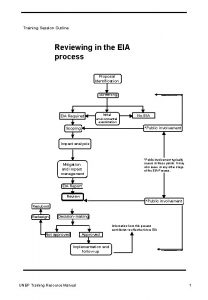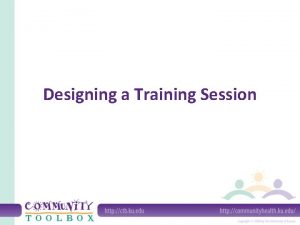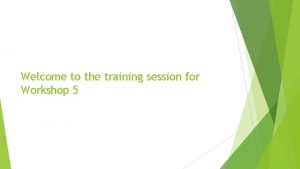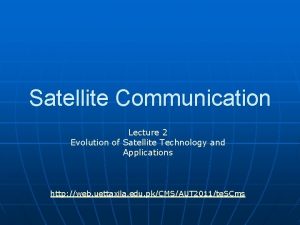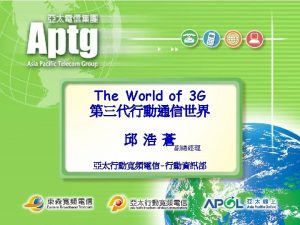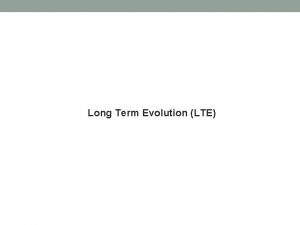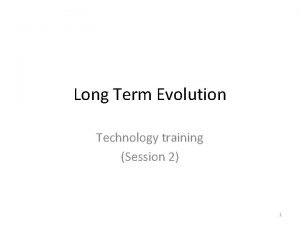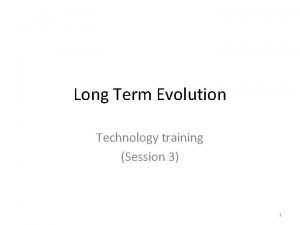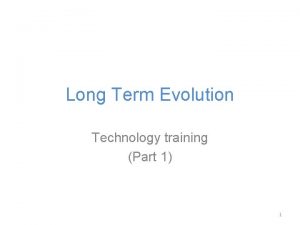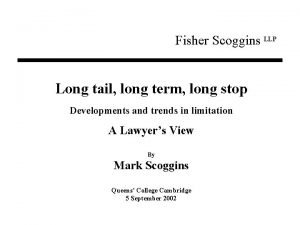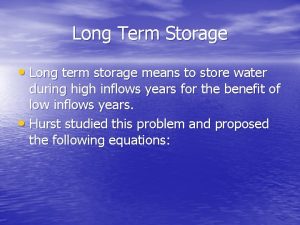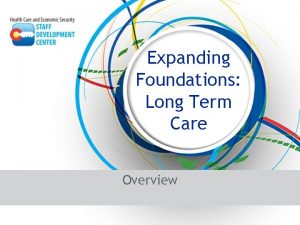Long Term Evolution Technology training Session 6 1


















- Slides: 18

Long Term Evolution Technology training (Session 6) 1

Multi antenna configuration • • LTE uses of multiple antennas at both communication ends LTE standard requires support for Downlink MIMO – 4 antennas at the e. Node. B – 2 antennas at the UE • Multiple antennas may be used in three principle ways – Reception/transmission diversity – Beam forming – Spatial multiplexing (MIMO antenna processing) • Downlink MIMO – TX diversity – Beam forming – Spatial multiplexing • Uplink MIMO – Multi user MIMO (SDMA) 2 Uplink MIMO Note: UL MU MIMO avoids use of multiple PAs at the UE

MIMO terminology • Transmission time interval (TTI) – – • Transport block (TB) – – • TB is processed through error control coding Data are encoded using CRC and Turbo encoder Data are scrambled using PCI and UE’s C-RNTI Layer – – • Packet of data passed from MAC to PHY During one TTI, PHY may receive either one or two TBs Code word – – – • LTE TTI is 1 ms long It extends over two time slots, i. e. 1 LTE sub frame Layer – parallel transmission of code words Code words are mapped into layers There may be as many layers as antenna ports Layers are pre-coded to equalize SNR for each layer Port – – Actual antenna port that transmits pre-coded layers There are 1 -4 ports in LTE and up to 8 ports in LTE-A Mapping TB to CW 3 Mapping CW to AP

Code word – layer – port mapping • • LTE uses either 1 or 2 code words Code words are mapped onto layers – 1 layer for 1 codeword – 2, 3 or 4 layers for 2 code words • Mapping between code-words and layers Number of modulation symbols in each layer is the same – Accomplished through numerous transportblock formats and sizes • Through a pre-coding matrix the layers are mapped onto the antennas – There is a set of pre-defined pre-coded matrices – Through PMI, UE recommends to e. Node. B which pre-coded matrix to use – e. Node. B may not follow UE’s recommendation – informs UE about precoding matrix through explicit signaling 4 Note: layers are mapped to antennas one symbol at the time

Antenna configurations • • 5 LTE (Rel 8) defines 7 transmission modes Decision on transmission mode – scheduler at e. Node B Implementation equipment vendor dependent Later LTE releases added more MIMO modes Transmission modes Description Comments 1 Single antenna (Port 0) Used for SISO and SIMO transmission 2 Transmit diversity Used in low SNR and high mobility 3 Open loop spatial multiplexing (large delay CDD) Beneficial in high SNR and rich multipath environment 4 Closed loop spatial multiplexing (Rank 2, 3 or 4) Beneficial in high SNR and rich multipath environment 5 Multi-user MIMO Beneficial in high SNR environment for interference reduction 6 Closed loop Rank = 1 Beneficial in low SNR environments 7 Single antenna port (Port 5) Used for beam forming of antenna arrays

TM 1: SIMO mode • • Default transmission mode Every other mode – explicit signaling Assumes one TX port (i. e. one antenna) One TB -> One CW -> One layer -> One port Mobile still may use diversity reception Not used often – limits the performance of DL Typical uses: – – 6 e. Node B with one physical antenna Simple UE with a very low traffic requirements M 2 M communication (simplified signaling) Limited coverage area

TM 2: DL transmit diversity • Two implementations – Cyclic Delay Diversity (CDD) – Space-Time Transmit Diversity (STTD) • CDD – Multiple antenna elements are used to introduce additional versions of the signal that are cyclically delayed – UE perceives these signals as additional multi-paths – Assuming low correlations between TX antennas –created “multi-paths” fade independently – source of diversity • CDD TX diversity STTD – Uses Space-Frequency Block Codes – Special encoding (SFBC) makes the channel matrix unitary (full rank) – Reference symbols are used to estimate and invert channel matrix SFBC TX diversity 7

TX Diversity - CDD • OFDM is robust with respect to multi-path propagation (within CP interval) CDD simulates multi-path propagation No modification in RX signal processing – UE ‘sees’ single antenna transmission in dispersive environment • • Note: Extension of CDD to more than 2 antennas is straightforward. Each antenna has its own cyclic delay. 8 Processing in case of 2 antenna CDD TX diversity

TX Diversity – 2 TX SFBC • Data sent to different antenna are encoded using SFBC – 2 symbols at the time for 2 antennas TX diversity – Open loop SFBC in case of 2 TX diversity Note 1: UE needs to have good estimate of the channel – estimate obtained using PHY reference sequences 9

TX Diversity – 4 TX SFBC • Data sent to different antenna are encoded using SFBC – 4 symbols at the time for 4 antennas TX diversity – TX diversity operates on a resource element group (REG) – Open loop SFBC in case of 4 TX diversity Note 1: 4 TX SFBC diversity may be seen as two 2 TX SFBC diversity transmissions multiplexed in time 10

Spatial multiplexing • Capacity benefit of SM MIMO Basic idea: fading channel provides uncorrelated parallel paths for data transmission Example: 2 by 2 Spectral efficiency (bps/Hz) NT NR 12. 00 10. 00 8. 00 C/W (1, 1) 6. 00 C/W (1, 2) 4. 00 C/W (2, 2) 2. 00 0 11 - number of TX antennas - number of RX antennas 5 S/N (d. B) 10 15

Spatial multiplexing in LTE • Two types – Open loop (used high speed scenarios) • Large delay Cyclic Delay Diversity (CDD) – Closed loop (used in low speed scenarios) • Mobile provides channel feedback to e. Node B Feedback Closed loop spatial multiplexing Open loop spatial multiplexing PMI (Pre-coded matrix indicator) PMI feedback from UE based on instantaneous channel state No feedback from UE. Fixed pre-coding at e. Node B implementing cyclic delay diversity (CDD) CQI (Channel quality indicator) Separate CQI for each code word Aggregate CQI (one value) RI (Rank indicator) Based on the rank of estimated channel matrix (indicates number of spatial channels) Based on the rank of estimated channel matrix when SFBCs are used 12 Closed loop spatial multiplexing

TM 3/4: Open/Closed loop spatial multiplexing • • • Open loop = no PMI, CQI and Rank are still provided Closed loop = PMI, CQI and Rank provided by UE 2 layers with different information on each layer Rank of channel is 2 May use 2 or 4 ports (antennas) If four antennas are used CDD is used on the same layer No PMI, e. Node. B cycles through a pre-defined sequence of PMIs (TM 3) PMI present = e. Node B uses the UE recommended PMI (TM 4) • • Note 1: UE recommends transmission mode configuration; UEs of different capabilities easily accommodated Note 2: PMI estimates only valid for slow moving mobiles 13

TM 5/6: MU-MIMO/Closed Loop Rank 1 TM 5 • Users are multiplexed in spatial domain • Scheduling for multiple users – – • • 14 Same frequency resources Different layers Requires very precise channel estimation Not used much in practice TM 6 • • • Functionally - TM 4 with Rank 1 One layer (i. e. one code word) PMI selected by the UE Appropriate for slow moving mobiles Not used much in practice

TM 7: Beam forming • • • Transmission mode used for beamforming Multiple antennas are used to form a higher gain beam towards the mobile This is accomplished through phase and amplitude scaling of individual ports This is rank 1 technique, i. e. it does not support spatial multiplexing Used predominantly as means to help UE’s at cell edge Note: transmission uses multiple antennas that are combined to act as a single high gain antenna 15

MIMO mode selection in LTE Note: “Green” modes are used more frequently than “red” modes. 16

Typical distribution of MIMO modes • Use of MIMO mode – scheduler decision • Most useful modes: – TM 4 (spatial multiplexing over rank 2 channel with precoding) – TM 3 (spatial multiplexing over rank channel without pre-coding) – TM 2 (transmit diversity) – TM 6 (closed loop MIMO over Rank 1 channel) 17 Example of an area and MIMO mode distribution

Section review 1. 2. 3. 4. 5. 6. 7. What is MIMO? What is receive diversity? What is transmit diversity? What is beam forming? What is SDMA? What is spatial multiplexing? How much is capacity of link increased using spatial multiplexing? 8. What is CQI? 9. What is RI? 10. How is RI used by the scheduler? 18 11. What is the main idea behind SFBC? 12. What is CDD? 13. Explain the main idea behind CDD?
 Long term evolution advanced
Long term evolution advanced Short medium and long term planning in education
Short medium and long term planning in education Long term memory vs short term memory
Long term memory vs short term memory Short term and long term human resource planning
Short term and long term human resource planning Difference between long term and short term liabilities
Difference between long term and short term liabilities Difference between long term and short term liabilities
Difference between long term and short term liabilities Short term goals
Short term goals Research paper on financial planning and forecasting
Research paper on financial planning and forecasting Tall+short h
Tall+short h Once upon a time there was a little girl
Once upon a time there was a little girl Training session outline
Training session outline Facilitate learning session
Facilitate learning session Training session design
Training session design Welcome to the training session
Welcome to the training session Talk boost tracker
Talk boost tracker Team4 nyla
Team4 nyla Molap vs rolap
Molap vs rolap Evolution of satellite technology
Evolution of satellite technology Evolution of information technology
Evolution of information technology










